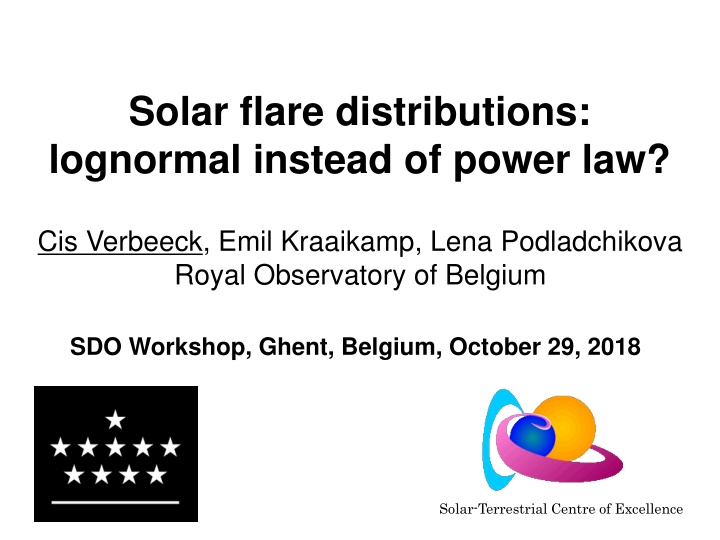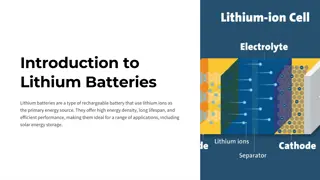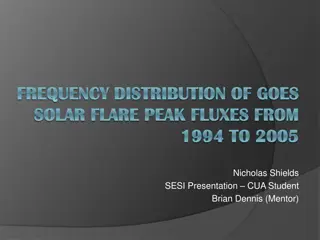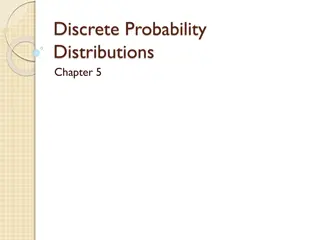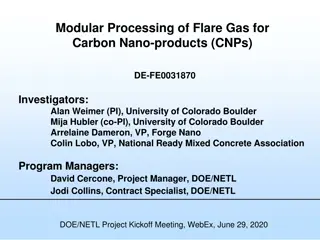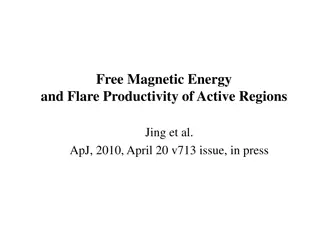Solar Flare Parameter Distributions Exploration
Solar flare distributions are studied, exploring lognormal distributions versus power law assumptions. Self-Organized Criticality (SOC) is discussed in relation to power law behavior. New data sets from SDO/AIA 94 are analyzed for flare detection accuracy and information extraction capabilities.
Download Presentation

Please find below an Image/Link to download the presentation.
The content on the website is provided AS IS for your information and personal use only. It may not be sold, licensed, or shared on other websites without obtaining consent from the author.If you encounter any issues during the download, it is possible that the publisher has removed the file from their server.
You are allowed to download the files provided on this website for personal or commercial use, subject to the condition that they are used lawfully. All files are the property of their respective owners.
The content on the website is provided AS IS for your information and personal use only. It may not be sold, licensed, or shared on other websites without obtaining consent from the author.
E N D
Presentation Transcript
Solar flare distributions: lognormal instead of power law? Cis Verbeeck, Emil Kraaikamp, Lena Podladchikova Royal Observatory of Belgium SDO Workshop, Ghent, Belgium, October 29, 2018 Solar-Terrestrial Centre of Excellence
Flare parameter distributions Flare parameter distributions are generally assumed to follow a power law Several authors have found power law behavior in flare parameter distributions and have estimated power law exponents Estimated exponents varied between 1.35 (Berghmans, Clette and Moses 1998) and 2.59 (Krucker and Benz 1998) Aschwanden et al., Space Sci Rev 2016
Self Organized Criticality (SOC) Power law behavior is often interpreted as Self Organized Criticality (SOC) SOC concept introduced by Bak et al., Phys Rev Lett 1987 Aschwanden, ApJ 2014: SOC is a critical state of a nonlinear energy dissipation system that is slowly and continuously driven towards a critical value of a system-wide instability threshold, producing scale- free, fractal-diffusive, and intermittent avalanches with powerlaw-like size distributions See review Aschwanden, Crosby et al., Space Sci Rev 2016 Lu & Hamilton, ApJ 1991: pile of magnetic fields model for solar flares Several more complex SOC models for solar flares Aschwanden, Crosby et al., Space Sci Rev 2016
New data set: SDO/AIA 94 flares detected by Solar Demon Solar Demon flare detection operates on SDO/AIA 94 synoptic level 1.5 science data @ 2 minute cadence On average, detects GOES B5 flares and above Accurate flare location and shape information (no macro-pixels, accurate on pixel-level) Able to distinguish simultaneous flares at different locations (unlike e.g., GOES flares) Background solar intensity does not affect the measured flare intensity Allows to filter the data, e.g., only consider flares that were entirely on-disk Big science catalog: 8 274 events in current data set (May 13, 2010 - March 16, 2018) Solar Demon an approach to detecting flares, dimmings, and EUV waves on SDO/AIA images, Kraaikamp and Verbeeck 2015, http://dx.doi.org/10.1051/swsc/2015019
Solar Demon Flare Detection http://solardemon.oma.be SDO/AIA 94 showing AR 2699 on February 7, 2018 A C8.1 flare detected by Solar Demon on February 7 at 13:38 UTC. For each detected flare, Solar Demon tracks the flare time, intensity, size, accurate location on pixel level, and pixel saturation. Solar Demon an approach to detecting flares, dimmings, and EUV waves on SDO/AIA images, Kraaikamp and Verbeeck 2015, http://dx.doi.org/10.1051/swsc/2015019
Solar Demon Flare Light Curves Flare intensity at time t = sum of all pixel values of the flare pixels in the image at time t Solar Demon an approach to detecting flares, dimmings, and EUV waves on SDO/AIA images, Kraaikamp and Verbeeck 2015, http://dx.doi.org/10.1051/swsc/2015019
Estimating the exponent Graphical method versus MLE Linear fit on log-log histogram Maximum Likelihood Estimation (MLE) Used very often Exploits the fact that power law Cumulative Distribution Function (CDF) is a straight line in a log-log plot Maximizes the log of likelihood function This leads to a single closed formula involving every data point xi: D Huys et al., Sol Phys 2016
Estimating the exponent Graphical method versus MLE Linear fit on log-log histogram Maximum Likelihood Estimation (MLE) Exploits the fact that power law Cumulative Distribution Function (CDF) is a straight line in a log-log plot Used very often Maximizes the log of likelihood function This leads to a single closed formula involving every data point xi: Lower cut-off xmin needs to be selected Lin or log bins, weighted or unweighted xmin is only parameter to be selected Accurate exponent estimation for samples of size ~102 or larger Very sensitive to bin size Accurate exponent estimation requires very large sample size (~104 or larger)
Robust statistical analysis of SDO/AIA 94 flare parameters In the present study, we follow the approach suggested by Clauset et al., SIAM Review 2009: Finding optimal value of xmin: for every value of xmin, calculate MLE fit(xmin), then minimize the Kolmogorov-Smirnov distance between the empirical distribution and the MLE fit(xmin) If xmin_s is the selected value of xmin, our best MLE fit to the data is MLE fit(xmin_s) Goodness-of-fit p is provided by bootstrapping. The hypothesis that the model is a reasonable fit to the data, is rejected if p < 0.1 Implementation: R package poweRlaw based on Clauset et al. method (Gillespie, J Stat Software 2015)
Data points 2010-2018 Solar Demon detected 8 274 on-disk flares between May 13, 2010 and March 16, 2018 Integrated flare intensity (left plot): short duration flares (consisting of only 1, 2 or a few images) create near empty horizontal bands in the lowest part of this plot Peak flare intensity (right plot): the blue, magenta, and red horizontal lines correspond roughly to GOES C1, M1 and X1 flares
SDO/AIA 94 , 2010-2018 (Solar Demon) Integrated flare intensity distribution not well-described by power law power law fit (2.10) 1.82 9 0.32 all data 4.21 100 Orders of magnitude % data points p-value
SDO/AIA 94 , 2010-2018 (Solar Demon) Peak flare intensity distribution not well-described by power law power law fit (2.32) 1.48 17 0.04 all data 2.47 100 Orders of magnitude % data points p-value
Power law exponent as a function of xmin For every value xmin(the lower cut-off value for the power law fit), we plot the exponent of the corresponding MLE power law fit. There is no range in xminwhere the exponent is near constant (horizontal regime). This also suggests that a power law model is not a good description of the data.
Introducing the lognormal distribution A random variable X is lognormally distributed if and only if Y = ln(X) has a normal distribution. If and are the mean and standard deviation of Y, then X = exp( + Z), with Z a standard normal variable. A lognormal process is the statistical realization of the product of many independent random variables, each of which is positive.
SDO/AIA 94 , 2010-2018 (Solar Demon) Integrated flare intensity distribution is well-described by lognormal power law fit (2.10) 1.82 9 0.32 lognormal fit 3.45 73 0.68 all data 4.21 100 Orders of magnitude % data points p-value Ratio test: lognormal significantly better than power law (test statistic: 34.81; p_one_sided: 0)
SDO/AIA 94 , 2010-2018 (Solar Demon) Peak flare intensity distribution is well-described by lognormal power law fit (2.32) 1.48 17 0.04 lognormal fit 2.39 92 0.28 all data 2.47 100 Orders of magnitude % data points p-value Ratio test: lognormal significantly better than power law (test statistic: 24.66; p_one_sided: 0)
Discussion How can this result be reconciled with the many papers that describe the power law distribution of flare parameters as observed in various data sets? Different studies do not agree on the actual power law exponent, finding a whole range of exponents both below and above 2 This divergence of exponent values may be partly due to pollution of the data sets by the solar background Data sets lacking spatial information about flares will typically classify simultaneous flares in different regions of the Sun as a single flare, adding bias to the data set It has been shown that first justifying and then fitting a power law model to data via graphical methods can be misleading (Clauset et al. 2009; D Huys et al. 2016) o Implications of lognormal instead of power law flare distributions: SOC paradigm for solar flares needs to be revisited. See next talk by Podladchikova et al. Do flares provide enough energy for coronal heating? The sufficiency criterion needs to be revisited.
Conclusion Flare data set detected by Solar Demon on SDO/AIA 94 synoptic level 1.5 science data 8 274 events (May 13, 2010 - March 16, 2018) Separate detection of simultaneous flares at different locations Background solar intensity does not affect the measured flare intensity Robust statistical analysis (MLE) of integrated and peak flare intensity distribution Comparing CCDF of data and power law fit, goodness-of-fit, and exponent stability plot all indicate that power law fit does not describe the data well Comparing CCDF of data and lognormal fit and goodness-of-fit indicate that lognormal fit does describe the data well Direct comparison (likelihood ratio) indicates that lognormal fit describes the data better than power law Lognormal fit is valid over much wider domain than power law fit (92% vs. 17% and 73% vs. 9% for peak and integrated intensity resp.) This work was submitted to Ap.J
Thank you for your attention! Questions?
Effect of pixel saturation (major flares) During major flare, 12 s cadence 94 AIA images alternate between default exposure time (often with saturated pixels) and Automatic Exposure Control (AEC), i.e., much shorter exposure time to avoid saturated pixels Comparing AEC (purple) and non-AEC (green) light curves in M5.4 flare 2010- 11-06T15:38:50, we observe 10% saturation AEC only light curve will avoid saturation, but requires importing images at much higher cadence (currently 2 minutes)
Effect of nonlinearity To which extent is the Solar Demon flare intensity linear w.r.t. GOES X ray flux? Linear relationship, but relatively large proportion of flares with high GOES X ray flux and low Solar Demon intensity.
Future ideas Take into account gradual degradation of AIA 94 channel over time Employ high cadence (12 s) AIA data for Solar Demon flare detections Removes effect of saturation in major flares More accurate parameter estimates such as peak intensity Investigate the effect of high cadence on the detection of faint, short duration flares Perform a similar analysis on other flare datasets, e.g., background- subtracted GOES X ray flares Compare power law and lognormal fits
Bootstrap convergence: power law for flare integrated brightness 24
Bootstrap convergence: lognormal for flare integrated brightness 25
